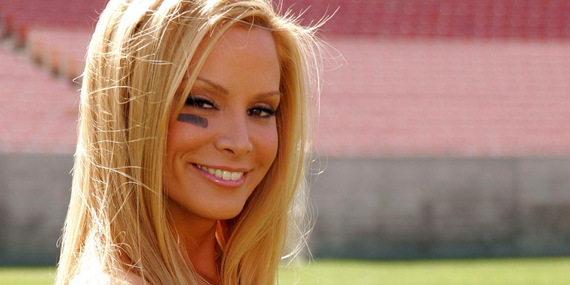"Are you ready to make some noise, Miami?!"
Yes, indeed. Cindy Margolis is more than just your typical entrepreneurial blonde/buxom beauty. She's also the self-proclaimed former Most Downloaded Woman in the World. But don't simply take her word for it: Instead, ask the hardworking people at a certain little publication known as THE GUINNESS BOOK OF WORLD RECORDS!
It would appear that within a specified daylong stretch in 1995, a snapshot of the Divine Miss M. was downloaded more than 70,000 times. To give a sense of perspective, that's 35,000 times more than the number of Collective Soul songs "borrowed" from the Internet during the same period. (No slight to Collective Soul, whose mid-'90s hit December was named Billboard's No. 1 Hot Album Rock Track and went on to win the Billboard Music Award for Album Rock Song of the Year -- giving the group the notable distinction of being the only band in history to earn the award two years in a row -- all while concurrently setting a rock radio record by remaining at the top of the charts for nine straight weeks).
So what transpires when the "chocolate" known as The Guinness Book of World Records accidentally gets dipped into the "peanut butter" known as our beloved Internet? Well, if there's an attractive young woman to be found somewhere in the middle, she's handed the keys to her own late-night TV show, natch.
The Cindy Margolis Show: a.k.a. the greatest television program in the history of, well, let's face it, history. A televised cabaret featuring music, games, celebrity guests and treasure chests crammed to the nines with a pirate's bounty of beefy guys, scantily-clad gals, and plankton-covered doubloons. (Okay, the latter perhaps not so much.) And yet it was canceled so very painfully prematurely. Throughout its oft-overlooked six-month run in the year 2000, it was deemed a "nonstop, weekly, one-hour party straight from the sands of Miami's South Beach." And rightfully so.
If the 21st Century actually began in 2000 as many would have you believe, surely this would have been heralded the Talk/Variety Show of the New Millennium. Sadly, given there is no year zero on the Gregorian calendar, Cindy will have to settle for the distinction of Most Kickin' Funky-Ass Talk/Variety Show of 1001 AD to 2000 AD. No easy feat, considering such notable competitors as The Party Machine With Nia Peeples (1991) and the show William the Conqueror was reputed to have briefly hosted shortly before defeating the English forces at the Battle of Hastings in 1066.
Of course, even the Most Downloaded Woman in the World couldn't have been expected to preside over the groove tube all by her lonesome. Enter her partners in crime: DJ Skribble and co-host "Crazee" Lance Krall. With regards to the esteemed Mr. Krall, rest easy in the knowledge that his nickname stemmed from his gregarious, off-the-wall charm, and not as a result of any documented form of mental affliction.
On those occasions where Krall or Cindy were not in front of the camera navigating the S.S. Margolis, the buffed/capable DJ Skribble was on hand to take the helm. Appearing comfortably "where it's at" behind his two turntables and a microphone, Skribble wasted little time cooking up a myriad of tasty "phat" beats upon which the fervent crowd could readily devour. ("Phat," as we know, being a popular idiomatic term denoting "good.")
Despite the boys' eager contributions, arguably the most popular feature on The Cindy Margolis Show was the weekly Webkini contest, where several women across the United States competed to be crowned Queen of South Beach. Logistically, the hypothesis would be that the term "Webkini" is essentially a lot like "bikini," only with the word "web" in it.
Yes granted, the Webkini contest was part of a television show and not actually broadcast on the web per se. (Which is a shame -- who wouldn't want to host this engaging content online?) However, this was at best a negligible oversight on the part of the producers, and most likely had little to do with the show's subsequent cancellation. If anything, much credit (or "cred," as they say in Miami) should be given to Cindy for creating a refreshing new addition to our stuffy King's English lexicon.
Right out of the gate, pundits and professional naysayers complained The Cindy Margolis Show had no substance. That it was bereft of actual format and relied on the thinnest shard of a premise. That it was nothing more than a forum for drunken spring-breaker types to convene each Saturday night and blurt out such exclamations as "Yeah, bay-bee," "Whoo!" and the occasional "Whoo-hoo!" That its sole purpose was to generate innumerable revenues by being packaged into syndication and marketed to dumb, swarthy European countries that border the Mediterranean. That it was being ground into a protein-like paste, mixed with roadkill, and secretly fed to USDA-approved cattle as a low-cost alternative to grain.
But such criticisms callously failed to take the bigger picture into account. Look, folks, let's be honest here. The transition from JPEG to television host isn't always a smooth one. Often, such elements as "movement" or "language" can initially be jarring to the faithful fan used to seeing his subject of choice in a static, 72-to-1200-dpi-induced state.
To boot, the Internet version of Cindy Margolis was, for all intents and purposes, a fairly low-maintenance mistress. Apart from A) the possible tedium of a weak wifi connection, or B) delays resulting from the occasional Windows update, cyber-Cindy was ready and willing to be accessed with a rousing immediacy.
TV Cindy, on the other hand, required more of an investment from the viewer. She could only be seen in weekly intervals and for no longer than one hour. Subtract 16 minutes for commercials, 10 minutes for the two segments allocated to the musical guest, 12 minutes for various contests and crowd shots, nine minutes for the celebrity guest star, eight minutes for decisive Skribble/Krall bantering, and you were only left with only about 180 seconds of quality Cindy Time per week.
Yet regardless of such surface restrictions, let's give TV Cindy a few kudos for possessing the necessary cojones required to "take it to the hoop," as one may be apt to say in the sport of basketball. For it has always been the pioneers of this industry who've had the valor and fortitude to persevere while shielding off the slings and arrows of outrageous criticism. And make no mistake, Cindy was a pioneer. In the same manner that Charles Chaplin moved from the silent era to talkies, in the same way Jack Benny smoothly eased over from radio to TV, rest assured Cindy Margolis will someday make that successful leap from the computer screen to the small screen and never look back.
The impact of the short-lived Margolis program (a.k.a. The Greatest Television Show of All Time Ever) should not be underestimated. Think of it as the Velvet Underground of late night television: influential, with a small, dedicated core audience. In fact, despite its cancellation, a veritable Pandora's Box of Internet-related television programming subsequently opened up, hitting the airwaves quicker than you could say "Miami's South Beach rules, bee-yotch!" Pioneer indeed.
In the final analysis, one may question whether it's this essay's objective to give this slice of television genius the proverbial "whitewash." Make no mistake: the answer is a resounding and emphatic "Not really!" Certainly, it could be argued that The Cindy Margolis Show, like any form of burgeoning programming out there, possessed some limitations. By playing the role of devil's advocate, pointed questions could conceivably be raised in an effort to expose such blemishes. These are your basic, run-of-the-mill queries that critical thinkers are expected to ask, yet in the grand scheme of things are probably no cause for alarm or concern. Take the following as examples:
- Why would a seemingly sentient individual act on the assumption that watching a party that showcases half-naked 21-year-olds is in some way similar to actually being at a party with half-naked 21-year-olds?
See? Questions so thoughtlessly insipid, they barely warrant a response. So pay no attention to the man behind the curtain. Whenever any doubts pop into your mind about the significance of Cindy Margolis' contribution to the new age of media, simply take solace in the reputable and virtuous words of the show's original press release: "Baby, it's the HOTTEST PAR-TEE (sic) in TOWN!"
"Are you ready to make some noise, Miami?!" Indeed, I believe you are.

